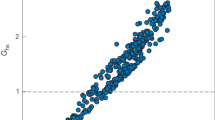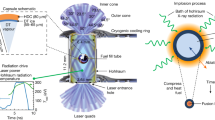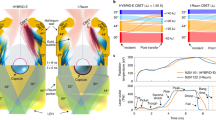Abstract
Focussing laser light onto the surface of a small target filled with deuterium and tritium implodes it and leads to the creation of a hot and dense plasma, in which thermonuclear fusion reactions occur. In order for the plasma to become self-sustaining, the heating of the plasma must be dominated by the energy provided by the fusion reactions—a condition known as a burning plasma. A metric for this is the generalized Lawson parameter, where values above around 0.8 imply a burning plasma. Here, we report on hydro-equivalent scaling of experimental results on the OMEGA laser system and show that these have achieved core conditions that reach a burning plasma when the central part of the plasma, the hotspot, is scaled in size by at least a factor of 3.9 ± 0.10, which would require a driver laser energy of at least 1.7 ± 0.13 MJ. In addition, we hydro-equivalently scale the results to the 2.15 MJ of laser energy available at the National Ignition Facility and find that these implosions reach 86% of the Lawson parameter required for ignition. Our results support direct-drive inertial confinement fusion as a credible approach for achieving thermonuclear ignition and net energy in laser fusion.
This is a preview of subscription content, access via your institution
Access options
Access Nature and 54 other Nature Portfolio journals
Get Nature+, our best-value online-access subscription
$29.99 / 30 days
cancel any time
Subscribe to this journal
Receive 12 print issues and online access
$209.00 per year
only $17.42 per issue
Buy this article
- Purchase on Springer Link
- Instant access to full article PDF
Prices may be subject to local taxes which are calculated during checkout




Similar content being viewed by others
Data availability
Raw data were generated at the OMEGA Laser Facility. Derived data supporting the findings of this study are available from the corresponding author upon request and with permission from the OMEGA Laser Facility.
References
Nuckolls, J., Wood, L., Thiessen, A. & Zimmerman, G. Laser compression of matter to super-high densities: thermonuclear (CTR) applications. Nature 239, 139–142 (1972).
Atzeni, S. & Meyer-ter-Vehn, J.The Physics of Inertial Fusion: Beam Plasma Interaction, Hydrodynamics, Hot Dense Matter 1st edn (Oxford Univ. Press, 2004); https://doi.org/10.1093/acprof:oso/9780198562641.001.0001
Lindl, J. D. Inertial Confinement Fusion: The Quest for Ignition and Energy Gain Using Indirect Drive (Springer-Verlag, 1998).
Craxton, R. S. et al. Direct-drive inertial confinement fusion: a review. Phys. Plasmas 22, 110501 (2015).
Slutz, S. A. et al. Pulsed-power-driven cylindrical liner implosions of laser preheated fuel magnetized with an axial field. Phys. Plasmas 17, 056303 (2010).
Chang, P. et al. Generalized measurable ignition criterion for inertial confinement fusion. Phys. Rev. Lett. 104, 135002 (2010).
Spears, B. K. et al. Performance metrics for inertial confinement fusion implosions: aspects of the technical framework for measuring progress in the National Ignition Campaign. Phys. Plasmas 19, 056316 (2012).
Christopherson, A. R. et al. Theory of ignition and burn propagation in inertial fusion implosions. Phys. Plasmas 27, 052708 (2020).
Betti, R. et al. Alpha heating and burning plasmas in inertial confinement fusion. Phys. Rev. Lett. 114, 255003 (2015).
Betti, R. & Hurricane, O. A. Inertial-confinement fusion with lasers. Nat. Phys. 12, 435–448 (2016).
Hurricane, O. A. et al. Inertially confined fusion plasmas dominated by alpha-particle self-heating. Nat. Phys. 12, 800–806 (2016).
Zylstra, A. B. et al. Burning plasma achieved in inertial fusion. Nature 601, 542–548 (2022).
Kritcher, A. L. et al. Design of inertial fusion implosions reaching the burning plasma regime. Nat. Phys. 18, 251–258 (2022).
Abu-Shawareb, H. et al. Lawson Criterion for ignition exceeded in an inertial fusion experiment. Phys. Rev. Lett. 129, 075001 (2022).
Hawker, N. A simplified economic model for inertial fusion. Philos. Trans. R. Soc. A 378, 20200053 (2020).
Nora, R. et al. Theory of hydro-equivalent ignition for inertial fusion and its applications to OMEGA and the National Ignition Facility.Phys. Plasmas 21, 056316 (2014).
Bose, A. et al. Core conditions for alpha heating attained in direct-drive inertial confinement fusion. Phys. Rev. E 94, 011201 (2016).
Gopalaswamy, V. et al. Tripled yield in direct-drive laser fusion through statistical modelling. Nature 565, 581–586 (2019).
Ding, Y. H., White, A. J., Hu, S. X., Certik, O. & Collins, L. A. Ab initio studies on the stopping power of warm dense matter with time-dependent orbital-free density functional theory. Phys. Rev. Lett. 121, 145001 (2018).
Regan, S. P. et al. Demonstration of fuel hot-spot pressure in excess of 50 Gbar for direct-drive, layered deuterium-tritium implosions on OMEGA. Phys. Rev. Lett. 117, 025001 (2016).
Mannion, O. M. et al. Mitigation of mode-one asymmetry in laser-direct-drive inertial confinement fusion implosions. Phys. Plasmas 28, 042701 (2021).
Lees, A. et al. Experimentally inferred fusion yield dependencies of OMEGA inertial confinement fusion implosions. Phys. Rev. Lett. 127, 105001 (2021).
Gopalaswamy, V. et al. Using statistical modeling to predict and understand fusion experiments. Phys. Plasmas 28, 122705 (2021).
Lees, A. et al. Understanding the fusion yield dependencies in OMEGA DT-layered implosion experiments using a physics-based statistical mapping model. Phys. Plasmas 30, 012709 (2023).
Williams, C. et al. First demonstration of hot-spot fuel gain exceeding unity in cryogenic direct-drive inertial confinement fusion. Nat. Phys. https://doi.org/10.1038/s41567-023-02363-2 (2024).
Hurricane, O. A. et al. Beyond alpha-heating: driving inertially confined fusion implosions toward a burning-plasma state on the National Ignition Facility. Plasma Phys. Contr. F. 61, 014033 (2018).
Hurricane, O. A. et al. Approaching a burning plasma on the NIF. Phys. Plasmas 26, 052704 (2019).
Delettrez, J., Epstein, R., Richardson, M. C., Jaanimagi, P. A. & Henke, B. L. Effect of laser illumination nonuniformity on the analysis of time-resolved X-ray measurements in uv spherical transport experiments. Phys. Rev. A 36, 3926–3934 (1987).
Radha, P. B. et al. Two-dimensional simulations of plastic-shell, direct-drive implosions on OMEGA. Phys. Plasmas 12, 032702 (2005).
Williams, C. A., Betti, R., Gopalaswamy, V. & Lees, A. High yields in direct-drive inertial confinement fusion using thin-ice DT liner targets. Phys. Plasmas 28, 122708 (2021).
Zhou, C. D. & Betti, R. Hydrodynamic relations for direct-drive fast-ignition and conventional inertial confinement fusion implosions. Phys. Plasmas 14, 072703 (2007).
Igumenshchev, I. V. et al. Crossed-beam energy transfer in implosion experiments on OMEGA. Phys. Plasmas 17, 122708 (2010).
Solodov, A. A. et al. Hot-electron preheat and mitigation in polar-direct-drive experiments at the National Ignition Facility. Phys. Rev. E 106, 055204 (2022).
Rosenberg, M. J. et al. Origins and scaling of hot-electron preheat in ignition-scale direct-drive inertial confinement fusion experiments. Phys. Rev. Lett. 120, 055001 (2018).
Lindl, J., Landen, O., Edwards, J. & Moses, E., NIC Team. Review of the National Ignition Campaign 2009-2012. Phys. Plasmas 21, 020501 (2014).
Hurricane, O. A. et al. On the importance of minimizing ‘coast-time’ in X-ray driven inertially confined fusion implosions. Phys. Plasmas 24, 092706 (2017).
Marozas, J. A. et al. First observation of cross-beam energy transfer mitigation for direct-drive inertial confinement fusion implosions using wavelength detuning at the National Ignition Facility. Phys.Rev. Lett. 120, 085001 (2018).
Rosenberg, M. J. et al. Hot electron preheat in hydrodynamically scaled direct-drive inertial confinement fusion implosions on the NIF and OMEGA. Phys. Plasmas 30, 072710 (2023).
Theobald, W. et al. Enhanced laser-energy coupling with small-spot distributed phase plates (SG5-650) in OMEGA DT cryogenic target implosions. Phys. Plasmas 29, 012705 (2022).
Hu, S. X. et al. Mitigating laser-imprint effects in direct-drive inertial confinement fusion implosions with an above-critical-density foam layer. Phys. Plasmas 25, 082710 (2018).
Ceurvorst, L. et al. Hybrid target design for imprint mitigation in direct-drive inertial confinement fusion. Phys. Rev. E 101, 063207 (2020).
Dorrer, C., Hill, E. M. & Zuegel, J. D. High-energy parametric amplification of spectrally incoherent broadband pulses. Opt. Express 28, 451–471 (2020).
Obenschain, S. et al. High-energy krypton fluoride lasers for inertial fusion. Appl. Optics 54, F103–F122 (2015).
Bates, J. W. et al. Suppressing cross-beam energy transfer with broadband lasers. High Energy Density Phys. 36, 100772 (2020).
Follett, R. K. et al. Thresholds of absolute two-plasmon-decay and stimulated Raman scattering instabilities driven by multiple broadband lasers. Phys. Plasmas 28, 032103 (2021).
Molvig, K., Hoffman, N. M., Albright, B. J., Nelson, E. M. & Webster, R. B. Knudsen Layer reduction of fusion reactivity. Phys. Rev. Lett. 109, 095001 (2012).
Amendt, P., Landen, O. L., Robey, H. F., Li, C. K. & Petrasso, R. D. Plasma barodiffusion in inertial-confinement-fusion implosions: application to observed yield anomalies in thermonuclear fuel mixtures. Phys. Rev. Lett. 105, 115005 (2010).
Bose, A., Woo, K. M., Nora, R. & Betti, R. Hydrodynamic scaling of the deceleration-phase Rayleigh–Taylor instability. Phys. Plasmas 22, 072702 (2015).
Boehly, T. R. et al. Optical and plasma smoothing of laser imprinting in targets driven by lasers with SSD bandwidths up to 1 THz. Phys. Plasmas 8, 2331–2337 (2001).
Skupsky, S. et al. Polar direct drive on the National Ignition Facility. Phys. Plasmas 11, 2763–2770 (2004).
Mannion, O. M. et al. A suite of neutron time-of-flight detectors to measure hot-spot motion in direct-drive inertial confinement fusion experiments on OMEGA. Nucl. Instrum. Meth. A 964, 163774 (2020).
Forrest, C. J. et al. High-resolution spectroscopy used to measure inertial confinement fusion neutron spectra on Omega. Rev. Sci. Instrum. 83, 10D919 (2012).
Gatu Johnson, M. et al. Measurement of apparent ion temperature using the magnetic recoil spectrometer at the OMEGA laser facility. Rev. Sci. Instrum. 89, 10I129 (2018).
Churnetski, K. et al. Three-dimensional hot-spot X-ray emission tomography from cryogenic deuterium-tritium direct-drive implosions on OMEGA. Rev. Sci. Instrum. 93, 093530 (2022).
Shah, R. C. et al. Bound on hot-spot mix in high-velocity, high-adiabat direct-drive cryogenic implosions based on comparison of absolute X-ray and neutron yields. Phys. Rev. E 106, L013201 (2022).
Oertel, J. A. et al. Framed monochromatic images of implosions taken with the joint LLE/LANL Gated Monochromatic X-ray Imager (GMXI). Annual Meeting of the American Physical Society Division Of Plasma Physics lWepP424 (American Physical Society, 1997).
Marshall, F. J. & Oertel, J. A. A framed monochromatic X-ray microscope for ICF (invited). Rev. Sci. Instrum. 68, 735–739 (1997).
Munro, D. H. Interpreting inertial fusion neutron spectra. Nucl. Fusion 56, 036001 (2016).
MacFarlane, J. J., Golovkin, I. E., Wang, P., Woodruff, P. R. & Pereyra, N. A. SPECT3D - A multi-dimensional collisional-radiative code for generating diagnostic signatures based on hydrodynamics and PIC simulation output. High Energy Density Phys. 3, 181–190 (2007).
Cao, D. et al. Interpreting the electron temperature inferred from X-ray continuum emission for direct-drive inertial confinement fusion implosions on OMEGA. Phys. Plasmas 26, 082709 (2019).
Gopalaswamy, V. et al. Analysis of limited coverage effects on areal density measurements in inertial confinement fusion implosions. Phys. Plasmas 29, 072706 (2022).
Acknowledgements
We thank P. Patel for discussions on comparing neutron and X-ray imaging at the NIF. This material is based upon work supported by the Department of Energy National Nuclear Security Administration under Award Number DE-NA0003856, the Department of Energy Office of Fusion Energy Sciences under Award Numbers DE-SC0021072, DE-SC0022132 and DE-SC0024381, the University of Rochester and the New York State Energy Research and Development Authority. This report was prepared as an account of work sponsored by an agency of the US Government. Neither the US Government nor any agency thereof, nor any of their employees, makes any warranty, express or implied, or assumes any legal liability or responsibility for the accuracy, completeness, or usefulness of any information, apparatus, product, or process disclosed, or represents that its use would not infringe privately owned rights. Reference herein to any specific commercial product, process or service by trade name, trademark, manufacturer or otherwise does not necessarily constitute or imply its endorsement, recommendation or favouring by the US Government or any agency thereof. The views and opinions of authors expressed herein do not necessarily state or reflect those of the US Government or any agency thereof.
Author information
Authors and Affiliations
Contributions
V.G. and R.B. conceived the study and wrote the paper. V.G., R.B., A.L. and R. Ejaz developed predictive models used to design high-performance experiments. V.G., C.A.W., R.B., D.P., J.P.K., A.L., D.C., P.F., R. Epstein, C.A.T., W.T., M.J.R., S.P.R., C. Stoeckl, V.N.G. designed and executed experiments used in training the predictive models used for this work. V.G., C.A.W., R.B., D.P., J.P.K., A.L. designed and executed the high-performance experiment series. D.C., K.S.A., RE, J.C.-N., I.V.I., J.A.M., P.B.R., A.A.S., T.J.B.C., S.X.H., W.S. and V.N.G. contributed to the radiation-hydrodynamic simulation development used in this work. V.G., C.J.F., V.Y.G., W.T., D.H.E., S.I., M.J.R., H.M., M.G.-J., R.D.P., J.A.F. and S.P.R. contributed to development and analysis of diagnostics used in this work. D.B., C.F., M.K., R.T.J., M.J.B., J.M., B.S., D.G., C. Shulberg, M.F. and D.R.H. were responsible for fielding the implosion targets used in this work. K.A.B., S.S. and L.J.W. were responsible for managing the OMEGA laser. M.L. and S.F.B.M. were responsible for managing the OMEGA facility and experimental operations. E.M.C. and C.D. were responsible for project management for the Laboratory for Laser Energetics.
Corresponding author
Ethics declarations
Competing interests
The authors declare no competing interests.
Peer review
Peer review information
Nature Physics thanks Vladimir Tikhonchuk and the other, anonymous, reviewer(s) for their contribution to the peer review of this work.
Additional information
Publisher’s note Springer Nature remains neutral with regard to jurisdictional claims in published maps and institutional affiliations.
Extended data
Extended Data Fig. 1 DD fusion yields from D2 gas-filled CH ablator implosion experiments on OMEGA and NIF.
DD fusion yields from D2 gas-filled CH ablator implosion experiments on OMEGA (diamonds) and NIF (circles), with (magenta) and without (blue) a Ge-doped CH inner payload layer. The black lines shows the expected yield of the NIF implosions for a range of energies according to hydro-equivalent scaling theory for the CH (solid) and CHGe (dash-dotted). The displayed yields and error bars are the median and 1 standard deviation of all the yields of implosions taken for each case, and the diagnostic measured value and 1 standard deviation uncertainty if there was only one implosion for that case. There were 4 NIF CHGe, 3 OMEGA CHGe, 2 NIF CH and 1 OMEGA CH implosions. OMEGA experiments are performed with smoothing by spectral dispersion49 (SSD) turned off and using a polar illumination scheme50 that mimics the illumination scheme of the NIF. OMEGA experiments occurred at 17 kJ, whereas the NIF experiments took place at 700 kJ, which corresponds to an increase in scale size S of approximate 3.5. When scaled down to OMEGA energies, the CH NIF implosions would be expected to produce (1.42 ± 0.12) × 109 neutrons, which is in good agreement with the (1.42 ± 0.07) × 109 neutrons measured on OMEGA. The CHGe NIF scaled down would be expected to produce (1.2 ± 0.3) × 109 neutrons, which is slightly higher than the OMEGA yields of (8.4 ± 0.8) × 108 neutrons. The ion temperatures for the NIF and OMEGA implosions are similar and roughly 2 keV. These implosion results support the validity of hydro-equivalent scaling of yields between OMEGA and NIF.
Extended Data Fig. 2 LILAC and DRACO no-α stagnation metrics for hydro-equivalently scaled implosions.
LILAC (blue circles) and DRACO (orange diamonds) no-α (that is, without alpha heating included in the simulations) stag- nation metrics for hydro-equivalently scaled implosions. a) DT Yield Ynoα, b) areal density ρR, c) Pressure, d) Hotspot Energy and e) the normalized Lawson parameter Xnoα, all versus the hydro-equivalently scaled driver energy (lower axis) and size scale factor (upper axis). Note that both horizontal axes are logarithmic. The solid black line indicates the change in the stagnation metrics according to scaling theory in Refs. 17,18 (Extended Data Table 1). There is good agreement with scaling theory for all the key observables, indicating that the simulations have been correctly scaled, and that the scaling theory remains valid for the moderate adiabat ( ~ 5) implosions which are the best performers on OMEGA, even in the presence of substantial 2D perturbations as expected from prior work48.
Extended Data Fig. 3 Design changes and corresponding effect on implosion dynamics from18 and this work.
a,b) The outer section of the pure CD ablator in (a) was replaced with a 5-7% silicon-doped CH ablator, and the ice thickness was slightly increased. (c) The pulse shape and various aspects of the simulation dynamics from LILAC post-shot simulations. Shot #90288 (the highest performer from18) is in blue, and shot 104949 is in magenta. The pulse shape is shortened and the intensity is increased from #90288. Due to the silicon in the outer ablator, CBET is mitigated, and the higher intensity first spike has the same absorption fraction, while the fixed intensity second spike has higher absorption. This results in a substantially higher maximum velocity (from 466 to 510 km/s) for the silicon doped implosion, despite the larger mass of the ice and ablator layers. The increased temperature of the coronal plasma due to silicon also reduced the threshold parameter and activity of the two-plasmon decay (TPD).
Rights and permissions
Springer Nature or its licensor (e.g. a society or other partner) holds exclusive rights to this article under a publishing agreement with the author(s) or other rightsholder(s); author self-archiving of the accepted manuscript version of this article is solely governed by the terms of such publishing agreement and applicable law.
About this article
Cite this article
Gopalaswamy, V., Williams, C.A., Betti, R. et al. Demonstration of a hydrodynamically equivalent burning plasma in direct-drive inertial confinement fusion. Nat. Phys. (2024). https://doi.org/10.1038/s41567-023-02361-4
Received:
Accepted:
Published:
DOI: https://doi.org/10.1038/s41567-023-02361-4
This article is cited by
-
A boost for laser fusion
Nature Physics (2024)
-
Demonstration of hot-spot fuel gain exceeding unity in direct-drive inertial confinement fusion implosions
Nature Physics (2024)



